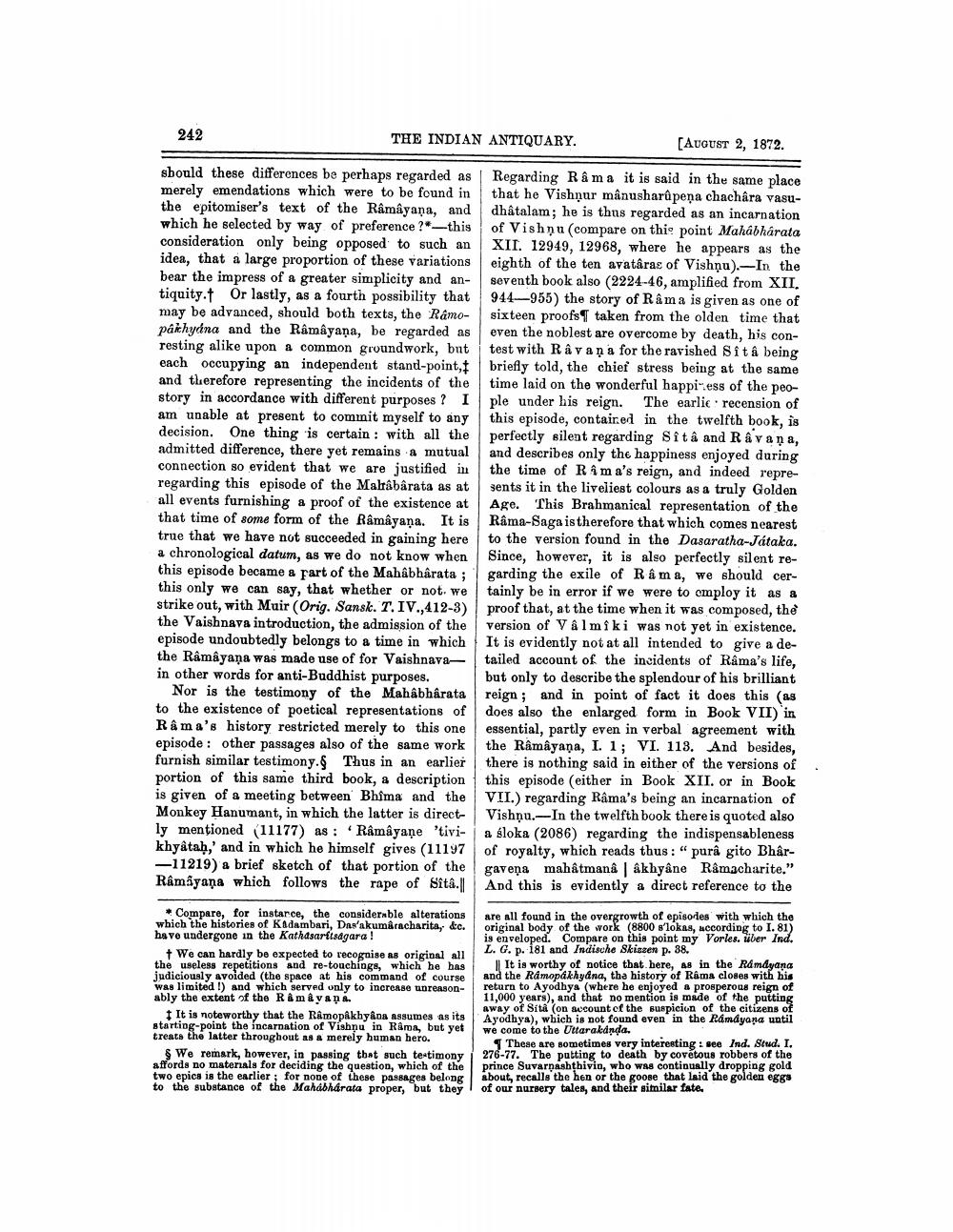________________
242
THE INDIAN ANTIQUARY.
[AUGUST 2, 1872.
should these differences be perhaps regarded as merely emendations which were to be found in the epitomiser's text of the Ramayana, and which he selected by way of preference? - this consideration only being opposed to such an idea, that a large proportion of these variations bear the impress of a greater simplicity and antiquity. Or lastly, as a fourth possibility that may be advanced, should both texts, the Ramopakhyana and the Ramayana, be regarded as resting alike upon a common groundwork, but each occupying an independent stand-point, and therefore representing the incidents of the story in accordance with different purposes ? I am unable at present to commit myself to any decision. One thing is certain : with all the admitted difference, there yet remains a mutual connection so evident that we are justified in regarding this episode of the Malabarata as at all events furnishing a proof of the existence at that time of some form of the Ramayana. It is true that we have not succeeded in gaining here a chronological datum, as we do not know when this episode became a part of the Mahâbhârata; this only we can say, that whether or not, we strike out, with Muir (Orig. Sansk. T. IV.,412-3) the Vaishnava introduction, the admission of the episode undoubtedly belongs to a time in which the Ramayana was made use of for Vaishnavain other words for anti-Buddhist purposes.
Nor is the testimony of the Mahabharata to the existence of poetical representations of Râma's history restricted merely to this one episode : other passages also of the same work furnish similar testimony. Thus in an earlier portion of this same third book, a description is given of a meeting between Bhima and the Monkey Hanumant, in which the latter is direct- ly mentioned (11177) as : Râmâyaņe 'tivi- khyatah,' and in which he himself gives (11197
a brief sketch of that portion of the Ramayana which follows the rape of Sita.
Regarding Râma it is said in the same place that he Vishnur mânusharûpeņa chachâra vasudhâtalam; he is thus regarded as an incarnation of Vishnu (compare on this point Mahabharata XII. 12949, 12968, where he appears as the eighth of the ten avatāras of Vishnu).-In the seventh book also (2224-46, amplified from XII. 944-955) the story of Râma is given as one of sixteen proofs taken from the olden time that even the noblest are overcome by death, his contest with Râvaņa for the ravished Sit â being briefly told, the chief stress being at the same time laid on the wonderful happi-.ess of the people under his reign. The earlie. recension of this episode, contaired in the twelfth book, is perfectly silent regarding Sitâ and Ravana, and describes only the happiness enjoyed during the time of Rama's reign, and indeed represents it in the liveliest colours as a truly Golden Age. This Brahmanical representation of the Râma-Saga is therefore that which comes nearest to the version found in the Dasaratha-Játaka. Since, however, it is also perfectly silent regarding the exile of Râma, we should certainly be in error if we were to employ it as a proof that, at the time when it was composed, the version of Valmiki was not yet in existence. It is evidently not at all intended to give a detailed account of the incidents of Rama's life, but only to describe the splendour of his brilliant reign; and in point of fact it does this (as does also the enlarged form in Book VII) in essential, partly even in verbal agreement with the Râmâyaņa, I. 1; VI. 113. And besides, there is nothing said in either of the versions of this episode (either in Book XII. or in Book VII.) regarding Râma's being an incarnation of Vishņu.- In the twelfth book there is quoted also a sloka (2086) regarding the indispensableness of royalty, which reads thus: “purâ gito Bhargaveņa mahâtmana | akhyâne Ramacharite." And this is evidently a direct reference to the
Compare, for instarce, the considerable alterations which the histories of Kadambari, Das'akumaracharita, &c. have undergone in the Kathasarftsdgara!
+ We can hardly be expected to recognise as original all the useless repetitions and re-touchings, which he has judiciously avoided (the space at his command of course was limited !) and which served only to increase unreasonably the extent of the Ramayana.
It is noteworthy that the Ramopakhyana assumes as its starting point the incarnation of Vishnu in Rame, but yet treats the latter throughout as a merely human hero.
We remark, however, in passing that such testimony affords no materals for deciding the question, which of the two epics is the earlier; for none of these passages belong to the substance of the Mandbadrata proper, but they
are all found in the overgrowth of episodes with which the original body of the work (8800 s lokas, according to I. 81) is enveloped. Compare on this point my Vorles. Liber Ind. L. G. p. 181 and Indische Skissen p. 38.
It is worthy of notice that here, as in the Ramayana and the Ramopathydna, tha history of Rama closes with his return to Ayodhya (where he enjoyed a prosperous reign of 11,000 years), and that no mention is made of the putting Away of Sin (on scount of the suspicion of the citizens of Ayodhya), which is not found even in the Randyana until
que to the Uttarakhound even in the of the citizens og
These are sometimes very interesting : see Ind. Stud. I. 276-77. The putting to death by covétous robbers of the prince Suvardashthivin, who was continually dropping gold about, recalls the hen or the goose that laid the golden er of our nursery tales, and their similar fate.




